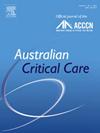A mixed-method evaluation of the acceptability, appropriateness, and feasibility of using an actionable processes of care checklist for patients with persistent critical illness
IF 2.7
3区 医学
Q2 CRITICAL CARE MEDICINE
引用次数: 0
Abstract
Background
Patients with persistent critical illness have care priorities distinct from those experiencing acute critical illness. We developed a checklist called “Action 11” incorporating actionable priorities of care for these patients.
Objective
The objective of this study was to evaluate the acceptability, appropriateness, and feasibility of using the Action 11 checklist.
Methods
A convergent mixed-method study was conducted in two units (unit 1 outside critical care; unit 2 inside critical care) of a community hospital in Canada caring for patients with persistent critical illness. The checklist was used daily for 4 weeks and then weekly for 4 weeks. A sample of healthcare providers was recruited to evaluate checklist acceptability, appropriateness, and feasibility using a questionnaire and interviews.
Results
We received 52 questionnaires and conducted 14 interviews (August–November 2022). Of the 52 completed questionnaires, 35 (67%), 42 (81%), and 41 (79%) had a score ≥16 for acceptability, appropriateness, and feasibility, respectively. Of a maximum score of 20, the total mean (standard deviation) scores for acceptability, appropriateness, and feasibility were 16.2 (2.9), 16.7 (2.4) and 17 (2.5), respectively. Participants from unit 1 found the checklist more acceptable (mean difference: 1.7, 95% confidence interval: [0.2–3.29]) and feasible (mean difference: 1.46, 95% confidence interval: [0.09–2.84]) to use than those from unit 2. Qualitative descriptions for acceptability (comprehensive, inclusive, straightforward, prevented omissions in care, and promoted professional accountability), appropriateness (suited patient needs and enabled a personalised, consistent, and collaborative approach to care), and feasibility (embedding into existing rounding, tailored to unit processes, and through leadership support) were also positive; however, they did not explain differences in rated acceptability and feasibility between the two units.
Conclusions
The Action 11 checklist was perceived as acceptable, appropriate, and feasible to use in units caring for patients with persistent critical illness. A larger-scale evaluation the of the Action 11 checklist exploring its effect on care processes and patient outcomes is recommended.
对持续性危重疾病患者使用可操作的护理核对表的可接受性、适当性和可行性进行混合方法评估
背景:持续性危重症患者的护理重点与急性危重症患者不同。我们制定了一份名为“行动11”的清单,其中包含了对这些患者可采取行动的优先护理。目的本研究的目的是评估使用行动11检查表的可接受性、适当性和可行性。方法采用融合混合方法研究两个单元(1单元非重症监护;加拿大一家社区医院的重症监护病房(第2单元),照顾患有持续性重症的病人。检查表每天使用4周,然后每周使用4周。我们招募了一批医疗保健提供者,通过问卷调查和访谈来评估检查表的可接受性、适当性和可行性。结果共收到52份问卷,进行14次访谈(2022年8月- 11月)。在完成的52份问卷中,35份(67%)、42份(81%)和41份(79%)的可接受性、适当性和可行性得分分别≥16分。在20分的满分中,可接受性、适当性和可行性的总平均(标准差)得分分别为16.2(2.9)、16.7(2.4)和17(2.5)。来自单元1的参与者发现,与来自单元2的参与者相比,使用清单更容易被接受(平均差值:1.7,95%可信区间:[0.2-3.29])和可行(平均差值:1.46,95%可信区间:[0.09-2.84])。对可接受性(全面、包容、直接、防止护理遗漏和促进专业问责)、适当性(适合患者需求并实现个性化、一致和协作的护理方法)和可行性(嵌入现有的舍入,根据单位流程量身定制,并通过领导支持)的定性描述也是积极的;然而,他们并没有解释两个单位在额定可接受性和可行性方面的差异。结论行动11检查表被认为是可接受的、适当的和可行的,可用于护理持续性危重患者的单位。建议对第11项行动清单进行更大规模的评估,探讨其对护理过程和患者预后的影响。
本文章由计算机程序翻译,如有差异,请以英文原文为准。
求助全文
约1分钟内获得全文
求助全文
来源期刊

Australian Critical Care
NURSING-NURSING
CiteScore
4.90
自引率
9.10%
发文量
148
审稿时长
>12 weeks
期刊介绍:
Australian Critical Care is the official journal of the Australian College of Critical Care Nurses (ACCCN). It is a bi-monthly peer-reviewed journal, providing clinically relevant research, reviews and articles of interest to the critical care community. Australian Critical Care publishes peer-reviewed scholarly papers that report research findings, research-based reviews, discussion papers and commentaries which are of interest to an international readership of critical care practitioners, educators, administrators and researchers. Interprofessional articles are welcomed.
 求助内容:
求助内容: 应助结果提醒方式:
应助结果提醒方式:


